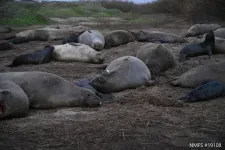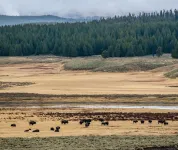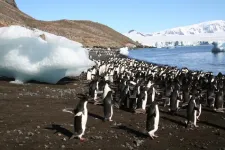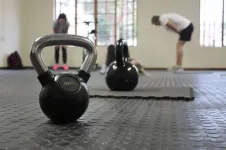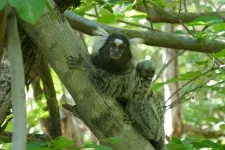(Press-News.org) Biologgers allow us to see with unprecedented precision how animals move and behave in the wild. But that's only part of the picture, according to a UC Santa Cruz ecologist renowned for using biologging data to tell the deeper story about the lives of marine mammals in a changing world.
In a new opinion piece published on October 30 in Trends in Ecology and Evolution, researchers present a framework intended to underscore the value of biologging data for testing important questions about the natural world. They urge that now is the time to build upon "discovery-based science," where observations are presented as research findings—by framing data collection, analysis, and interpretation around specific questions posed by scientific theories.
"We emphasize the power and promise of theory-driven research," said study lead author Roxanne Beltran, assistant professor of ecology and evolutionary biology. "For example, if we hypothesize that animals take more risks when they're more hungry, can we use biologging tools to test and refine this theory by measuring both hunger and risk-taking in wildlife?"
In other words, instead of doing research that concludes with describing the data, researchers can now begin with a general idea of how the natural world works, and then use biologgers attached to animals to strategically test whether that idea is supported by data.
How biologgers can help generalize insights
In their review, the team demonstrates how biologgers can be a powerful tool for testing hypotheses and refining theories via case studies of elephant seals, whooping cranes, and mule deer. These case studies demonstrate that observations made from biologgers can lead to insights that inform hypotheses and refine ecological theories. Using ecological theory to link the physiology, sociality, and demography of an animal with its environmental context allows for a better understanding of these systems, the piece states.
For example, depth-measuring biologgers attached to northern elephant seals revealed that, at certain points, the animals stopped swimming and started passively drifting. This previous research led to the hypothesis that seals might drift because they are asleep, and that this might be due to differences in physiology.
With biologgers, researchers were able to confirm that seals with superior body condition (more body fat) skipped foraging at night to sleep in the safety of darkness. In contrast, seals with inferior body condition (less body fat) foraged at night, when it was more efficient, but then risked sleeping during the day when risk of predation from sharks and killer whales was higher. This led to support of state-dependent risk-taking theory, backed by biologging data, that wild animals are more likely to take risks when they are in poorer body condition.
“We've used these case studies as examples of the many exciting opportunities for new insights across finer temporal scales and broader spatial scales than ever before,” Beltran said. “We hope that our framework makes others feel excited and motivated by how much potential we have to apply these biologging tools and generate ecological insights in the next couple of decades.”
More inclusivity in ecology research
In addition to her marine ecology research, Beltran has strongly advocated for diversity, equity, and inclusion in STEM through the development of actionable field guides on anti-racism, community building, and inclusive research experiences. In this new piece, she calls for open access to biologger data so scientists without the resources to acquire expensive technology can still contribute to the field.
Eighteen of the article's authors are early-career researchers, including graduate students, postdocs, and research technicians like Conner Hale, who contributed by conceptualizing the case studies into a graphic for the paper. She started in Beltran's lab as an undergraduate field assistant three years ago and now works with Beltran full time.
“I was involved from the ground up in creating Figure 2. Working on it allowed me to improve my science communication skills, gain experience in simplifying text into an image, and collaborate with my team, which are skills that will benefit me as I continue to pursue a career in research,” said Hale (Carson, ‘22, marine biology). “I'm currently doing the kind of research that I hope to pursue in grad school, and getting this experience now is setting me up for success.”
Beltran said collaborating with colleagues locally and internationally was crucial for showing the scientific community how biologgers can be used to produce more holistic research in the years ahead. “I knew that I could lead a much more powerful paper if I brought together a large group of young researchers who had unique but complementary visions for the future of the field,” she explained.
The future of biologging
One exciting next step identified by the researchers is to expand the scale of inquiry. For instance, researchers could leverage theories about species interactions to motivate the simultaneous tagging of predators and prey in the same ecosystem. Mathematical models could then be used to create simulations of populations, communities, and ecosystems under climate change scenarios that would ultimately inform evidence-based conservation solutions.
“When disciplines are new, they necessarily begin with discovery of patterns,” Beltran said. “We believe that transitioning toward process-based insights will allow biologging science to continue having an enormous impact on our understanding of the natural world.”
Other co-authors of the paper from UC Santa Cruz include A. Marm Kilpatrick, Arina Favilla, Allison Payne, Danial Palance, Daphne Shen, Dan Costa, Natalie Storm, and Patrick Robinson. The team also included contributors from the University of Idaho, University of Washington, University of Wyoming, UC Davis, UC San Diego, Stanford University, Monterey Bay Aquarium Research Institute, National Institute of Polar Research in Japan, and University of Southampton in the UK.
The paper, “Maximizing biological insights from instruments attached to animals,” was funded by a Packard Fellowship in Science and Engineering, a Beckman Young Investigator award, an Office of Naval Research Young Investigator award, and a generous private donation through the Elysea Fund.
END
How researchers can maximize biological insights using animal-tracking devices
A group of international researchers outlines a vision for the future of biologging
2024-10-30
ELSE PRESS RELEASES FROM THIS DATE:
Research shows new method helps doctors safely remove dangerous heart infections without surgery
2024-10-30
ROCHESTER, Minn. — Doctors at Mayo Clinic used a new catheter-based approach to draw out resistant pockets of infection that settle in the heart, known as right-sided infective endocarditis, without surgery. Unless treated quickly, the walled-off infections can grow, severely damaging heart valves and potentially affecting other organs as well. In a recent study, over 90% of the participants had their infection cleared, and they had lower in-hospital mortality compared to those whose infections remained.
The research is part of a Mayo Clinic-led study ...
Rapid horizontal eye movement can improve stability in people with Parkinson’s
2024-10-30
Rapid side-to-side eye movements can help stabilize posture, avoid falls and maintain balance for people with Parkinson’s disease, just as they can for healthy people. This seemingly counterintuitive conclusion was reached by researchers at São Paulo State University (UNESP) in Brazil and the University of Lille in France in a study supported by FAPESP. An article on the study is published in the journal Biomechanics.
Ten individuals diagnosed with Parkinson’s and 11 neurologically healthy individuals participated in the study. All participants were over 60 and were submitted to tests that ...
Study finds COVID-19 pandemic worsened patient safety measures
2024-10-30
PHILADELPHIA (October 30, 2024) – A new study – published in Nursing Research – has found that the COVID-19 pandemic significantly impacted patient safety indicators in U.S. hospitals. The study, from Penn Nursing’s Center for Health Outcomes and Policy Research (CHOPR), examined data from the National Database of Nursing Quality Indicators to assess trends in nursing-sensitive quality indicators from 2019 to 2022. The prevention of these very distressing, uncomfortable conditions is considered to be under the nurse’s purview and directly influenced by nursing care.
The investigation found that rates of falls, bloodstream infections from ...
Costs still on the rise for drugs for neurological diseases
2024-10-30
MINNEAPOLIS – The amount of money people pay out-of-pocket for branded drugs to treat neurological diseases like multiple sclerosis (MS), Alzheimer’s, and Parkinson’s disease continues to rise, especially for MS drugs, according to a study published in the October 30, 2024, online issue of Neurology®, the medical journal of the American Academy of Neurology. The study found that average out-of-pocket costs for drugs for MS increased by 217% over a nine-year period.
Costs have dropped for medications where generic versions have been introduced.
“In some ...
Large herbivores have lived in Yellowstone National Park for more than 2,000 years
2024-10-30
Large herbivores like bison or elk have continuously lived in the Yellowstone National Park region for about 2,300 years according to a new analysis of chemicals preserved in lake sediments. John Wendt of Oklahoma State University, U.S., and colleagues present these findings in the open-access journal PLOS ONE on October 30, 2024.
The near-extinction of bison in North America in the 19th and 20th centuries was a major ecological catastrophe and little is known about where and how these animals lived before European colonization. In the new study, researchers attempted to determine the dominant large herbivores that lived in the northern Yellowstone National Park ...
Antarctic penguin colonies can be identified and tracked from tourists' photos, using a computer model to reconstruct the 3D scene
2024-10-30
Antarctic penguin colonies can be identified and tracked from tourists' photos, using a computer model to reconstruct the 3D scene
###
Article URL: https://journals.plos.org/plosone/article?id=10.1371/journal.pone.0311038
Article Title: Penguin colony georegistration using camera pose estimation and phototourism
Author Countries: U.S.A.
Funding: This work was supported in part by the NASA Biodiversity Program (Award 317 80NSSC21K1027), and NSF Grant IIS-2212046. The funders had no say in the study design, data collection and analysis, decision to publish, or preparation of the manuscript. END ...
For patients with alcohol use disorder, exercise not only reduces alcohol dependence, but also improves mental and physical health, per systematic review
2024-10-30
For patients with alcohol use disorder, exercise not only reduces alcohol dependence, but also improves mental and physical health, per systematic review
###
Article URL: https://journals.plos.org/plosone/article?id=10.1371/journal.pone.0311166
Article Title: Effectiveness of exercise intervention in improving physical and mental status of patients with alcohol use disorders: A systematic review and meta-analysis
Author Countries: China
Funding: This study was funded by a grant from the National ...
Bones from Tudor Mary Rose shipwreck suggest handedness might affect collarbone chemistry
2024-10-30
Editor's Note: Please do not include the image originally uploaded with this release in any of your coverage as the licensing information has now changed. Please contact onepress@plos.org for any questions. Updated: October 30, 2024
A new study of human skeletal remains from the wreck of the 16th century English warship Mary Rose suggests that whether a person is right- versus left-handed may influence how their clavicle bone chemistry changes as they age. Dr. Sheona Shankland of Lancaster University, U.K., and colleagues present these findings in the open-access journal PLOS ONE on October 30, 2024.
The ...
Farewell frost! New surface prevents frost without heat
2024-10-30
Someday, people might finally say goodbye to defrosting the freezer or scraping frost off slippery surfaces. Northwestern University engineers have developed a new strategy that prevents frost formation before it begins.
In a new study, the researchers discovered that tweaking the texture of any surface and adding a thin layer of graphene oxide prevents 100% of frost from forming on surfaces for one week or potentially even longer. This is 1,000 times longer than current, state-of-the-art anti-frosting surfaces.
As an added bonus, ...
Similarities in brain development between marmosets and humans
2024-10-30
The development of primate brains is shaped by various inputs. However, these inputs differ between independent breeders, such as great apes, and cooperative breeders, such as the common marmoset (Callithrix jacchus) and humans. In these species, group members other than the parents contribute substantially to raising the infants from birth onwards.
A group of international researchers led by Paola Cerrito from the University of Zurich’s Department of Evolutionary Anthropology studied how such social interactions map onto brain development in common marmosets. The study provides new insights into the relationship between the timing of brain development ...
LAST 30 PRESS RELEASES:
Tracing the quick synthesis of an industrially important catalyst
New software sheds light on cancer’s hidden genetic networks
UT Health San Antonio awarded $3 million in CPRIT grants to bolster cancer research and prevention efforts in South Texas
Third symposium spotlights global challenge of new contaminants in China’s fight against pollution
From straw to soil harmony: International team reveals how biochar supercharges carbon-smart farming
Myeloma: How AI is redrawing the map of cancer care
Manhattan E. Charurat, Ph.D., MHS invested as the Homer and Martha Gudelsky Distinguished Professor in Medicine at the University of Maryland School of Medicine
Insilico Medicine’s Pharma.AI Q4 Winter Launch Recap: Revolutionizing drug discovery with cutting-edge AI innovations, accelerating the path to pharmaceutical superintelligence
Nanoplastics have diet-dependent impacts on digestive system health
Brain neuron death occurs throughout life and increases with age, a natural human protein drug may halt neuron death in Alzheimer’s disease
SPIE and CLP announce the recipients of the 2025 Advanced Photonics Young Innovator Award
Lessons from the Caldor Fire’s Christmas Valley ‘Miracle’
Ant societies rose by trading individual protection for collective power
Research reveals how ancient viral DNA shapes early embryonic development
A molecular gatekeeper that controls protein synthesis
New ‘cloaking device’ concept to shield sensitive tech from magnetic fields
Researchers show impact of mountain building and climate change on alpine biodiversity
Study models the transition from Neanderthals to modern humans in Europe
University of Phoenix College of Doctoral Studies releases white paper on AI-driven skilling to reduce burnout and restore worker autonomy
AIs fail at the game of visual “telephone”
The levers for a sustainable food system
Potential changes in US homelessness by ending federal support for housing first programs
Vulnerability of large language models to prompt injection when providing medical advice
Researchers develop new system for high-energy-density, long-life, multi-electron transfer bromine-based flow batteries
Ending federal support for housing first programs could increase U.S. homelessness by 5% in one year, new JAMA study finds
New research uncovers molecular ‘safety switch’ shielding cancers from immune attack
Bacteria resisting viral infection can still sink carbon to ocean floor
Younger biological age may increase depression risk in older women during COVID-19
Bharat Innovates 2026 National Basecamp Showcases India’s Most Promising Deep-Tech Ventures
Here’s what determines whether your income level rises or falls
[Press-News.org] How researchers can maximize biological insights using animal-tracking devicesA group of international researchers outlines a vision for the future of biologging
